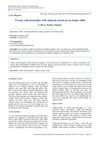The Involvement of RIPK1 in Alopecia Areata
February 2025
in “
International Journal of Molecular Sciences
”

TLDR RIPK1 inhibitors may help prevent alopecia areata by reducing immune cell activity.
The study explores the role of receptor-interacting serine threonine kinase 1 (RIPK1) in alopecia areata (AA) using a mouse model. It was observed that RIPK1 expression is elevated in AA-affected skin, particularly in dendritic cells and CD8+ T cells. Inhibiting RIPK1 with Necrostatin-1s and GSK2982772 delayed AA onset, reduced immune cell presence in the skin, and increased hair length in a hair organ culture model. The study involved 7 mice per group for Nec-1s treatment and 12 mice per group for GSK2982772 treatment. These findings suggest that RIPK1 inhibitors could potentially prevent AA onset and promote hair growth, indicating a promising therapeutic approach for AA.




